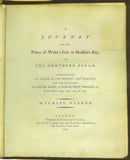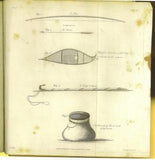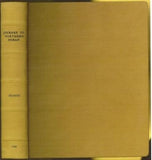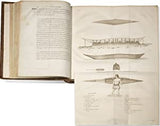A journey from Prince of Wales's Fort in Hudson's Bay to the northern ocean: Undertaken by order of the Hudson's Bay Company for the discovery of copper mines, a north west passage, &c. in the years 1769, 1770, 1771, & 1772
Author: Hearne, Samuel (1745-1792)
Year: 1795
Publisher: Printed for A Strahan and T Cadell
Place: London
Description:
xliv+458 pages with two (of four) engraved plates after drawings by the author (both folding) and four (of five) folding engraved maps. Quarto (11 3/4" x 9 3/4") bound in full leather with raised spine bands and gilt lettering to spine. (HillI, page 141. Sabin 31181) First edition.
Manuscript journal was found by La Perouse when he captured Fort Albany; later one of his conditions of surrender was that it be published. Samuel Hearne was an explorer, fur-trader, author, and naturalist. He was the first European to make an overland excursion across northern Canada to the Arctic Ocean In 1774 Hearne built Cumberland House for the Hudson's Bay Company, its first interior trading post and the first permanent settlement in present Saskatchewan. From 1769 to 1772, Hearne was employed in north-western discovery, searching especially for certain copper mines described by Indians as "Far-Away-Metal River". These copper mines were found in the Barren Lands where the ground is permanently frozen to within a few inches of the surface, creating, in many areas, vast stretches of mosquito- and fly-infested swamp during the summer thaw. For this reason, it was decided that travel in winter was preferable. His first attempt began on 6 November 1769. The large size of the expedition and too much European equipment being carried led to the desertion of his Indian guides and the failure of the expedition. His second, commencing 23 February 1770, failed because his quadrant was broken and much of his equipment was stolen. Learning from the mistakes of the first two expeditions Hearne contrived to travel as the only European with a group of Indians led by the great chief Matonabbee. The group also included eight of Matonabbee's wives to act as beasts of burden in the sledge traces, camp servants, and cooks. This third expedition set out in December 1770, in order to reach the Coppermine River in summer, by which he could descend to the Arctic in canoes. Matonabbee kept a fast pace, so fast they reached the great caribou traverse before provisions dwindled and in time for the spring hunt. Here all the Indian hunters of the north gathered to hunt the vast herds of caribou migrating north for summer. A store of meat was laid up for Hearne's voyage and a band of warriors joined the expedition. Matonabbee ordered the women to wait for his return in the Athabasca country to the west. The Chipewyan were generally a mild and peaceful people, however they were in a state of conflict with the Inuit. A great number of Indians joined Hearne's party to accompany them to the Coppermine River with intent to murder Inuit, who were understood to frequent that river in considerable numbers. On July 14, 1771, they reached the Coppermine River, a small stream flowing over a rocky bed in the "Barren Lands of the Little Sticks". A few miles down the river, just above a cataract, were the domed wigwams of an Eskimo camp. At 1am on July 17, 1771 Matonabbee and the other Indians fell upon the sleeping Eskimo in a ruthless massacre. Approximately twenty men, women and children were killed; this would be known as the Massacre at Bloody Falls. A few days later Hearne was the first European to reach the shore of the Arctic Ocean by an overland route. By tracing the Coppermine River to the Arctic Ocean, he had established there was no northwest passage through the continent at lower latitudes. This expedition also proved successful in its primary goal by discovering copper in the Coppermine River basin. However, an intensive search of the area yielded only one four-pound lump of copper and commercial mining was not considered viable. Matonabbee led Hearne back to Churchill by a wide westward circle past Bear Lake in Athabasca Country. In midwinter he became the first European to see and cross Great Slave Lake. Hearne returned to Fort Prince of Wales on 30 June 1772 having walked some 5,000 miles and explored more than 250,000 square miles. Condition: Rebound in attractive leather with raised spine bands. Lacks frontispiece map and two plates. Plate I (A North West View of Prince of Wales's Fort) and Plate IV (A Winter view of the Athapuscow Lake). Some internal spotting. Small repair to title page and verso and front free end paper edge, else a better than very good copy.
Condition:
Rebound in attractive leather with raised spine bands. Lacks frontispiece map and two plates. Plate I (A North West View of Prince of Wales's Fort) and Plate IV (A Winter view of the Athapuscow Lake). Some internal spotting. Small repair to title page and verso and front free end paper edge, else a better than very good copy.
Year: 1795
Publisher: Printed for A Strahan and T Cadell
Place: London
Description:
xliv+458 pages with two (of four) engraved plates after drawings by the author (both folding) and four (of five) folding engraved maps. Quarto (11 3/4" x 9 3/4") bound in full leather with raised spine bands and gilt lettering to spine. (HillI, page 141. Sabin 31181) First edition.
Manuscript journal was found by La Perouse when he captured Fort Albany; later one of his conditions of surrender was that it be published. Samuel Hearne was an explorer, fur-trader, author, and naturalist. He was the first European to make an overland excursion across northern Canada to the Arctic Ocean In 1774 Hearne built Cumberland House for the Hudson's Bay Company, its first interior trading post and the first permanent settlement in present Saskatchewan. From 1769 to 1772, Hearne was employed in north-western discovery, searching especially for certain copper mines described by Indians as "Far-Away-Metal River". These copper mines were found in the Barren Lands where the ground is permanently frozen to within a few inches of the surface, creating, in many areas, vast stretches of mosquito- and fly-infested swamp during the summer thaw. For this reason, it was decided that travel in winter was preferable. His first attempt began on 6 November 1769. The large size of the expedition and too much European equipment being carried led to the desertion of his Indian guides and the failure of the expedition. His second, commencing 23 February 1770, failed because his quadrant was broken and much of his equipment was stolen. Learning from the mistakes of the first two expeditions Hearne contrived to travel as the only European with a group of Indians led by the great chief Matonabbee. The group also included eight of Matonabbee's wives to act as beasts of burden in the sledge traces, camp servants, and cooks. This third expedition set out in December 1770, in order to reach the Coppermine River in summer, by which he could descend to the Arctic in canoes. Matonabbee kept a fast pace, so fast they reached the great caribou traverse before provisions dwindled and in time for the spring hunt. Here all the Indian hunters of the north gathered to hunt the vast herds of caribou migrating north for summer. A store of meat was laid up for Hearne's voyage and a band of warriors joined the expedition. Matonabbee ordered the women to wait for his return in the Athabasca country to the west. The Chipewyan were generally a mild and peaceful people, however they were in a state of conflict with the Inuit. A great number of Indians joined Hearne's party to accompany them to the Coppermine River with intent to murder Inuit, who were understood to frequent that river in considerable numbers. On July 14, 1771, they reached the Coppermine River, a small stream flowing over a rocky bed in the "Barren Lands of the Little Sticks". A few miles down the river, just above a cataract, were the domed wigwams of an Eskimo camp. At 1am on July 17, 1771 Matonabbee and the other Indians fell upon the sleeping Eskimo in a ruthless massacre. Approximately twenty men, women and children were killed; this would be known as the Massacre at Bloody Falls. A few days later Hearne was the first European to reach the shore of the Arctic Ocean by an overland route. By tracing the Coppermine River to the Arctic Ocean, he had established there was no northwest passage through the continent at lower latitudes. This expedition also proved successful in its primary goal by discovering copper in the Coppermine River basin. However, an intensive search of the area yielded only one four-pound lump of copper and commercial mining was not considered viable. Matonabbee led Hearne back to Churchill by a wide westward circle past Bear Lake in Athabasca Country. In midwinter he became the first European to see and cross Great Slave Lake. Hearne returned to Fort Prince of Wales on 30 June 1772 having walked some 5,000 miles and explored more than 250,000 square miles. Condition: Rebound in attractive leather with raised spine bands. Lacks frontispiece map and two plates. Plate I (A North West View of Prince of Wales's Fort) and Plate IV (A Winter view of the Athapuscow Lake). Some internal spotting. Small repair to title page and verso and front free end paper edge, else a better than very good copy.
Condition:
Rebound in attractive leather with raised spine bands. Lacks frontispiece map and two plates. Plate I (A North West View of Prince of Wales's Fort) and Plate IV (A Winter view of the Athapuscow Lake). Some internal spotting. Small repair to title page and verso and front free end paper edge, else a better than very good copy.















